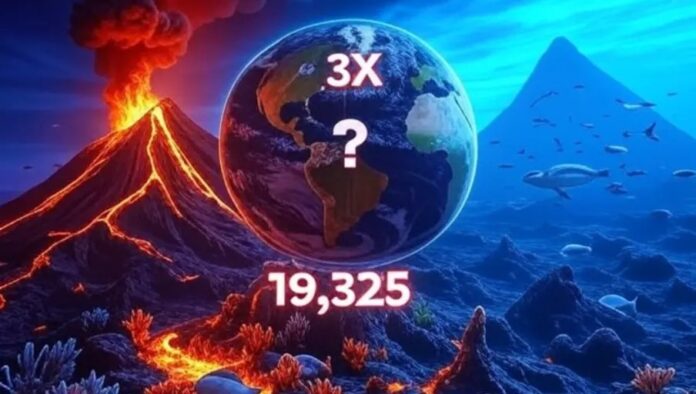Folks, hold onto your hats—two groundbreaking studies dropped this past month, and they’re shaking up everything we thought we knew about carbon dioxide (CO2) in Earth’s atmosphere. The first, from The University of Manchester, reveals that volcanic CO2 emissions could be three times higher than previously estimated. The second, from the School of Ocean and Earth Science and Technology (SOEST), uncovers a staggering 19,325 previously unknown undersea volcanoes. Together, these findings throw a massive wrench into the narrative that human activity is the sole driver of rising atmospheric CO2. Let’s dive in.
Manchester’s Volcanic CO2 Bombshell might be a game changer. The Manchester team, led by Alexander Riddell, deployed cutting-edge sensors on a helicopter to measure emissions from the Soufrière Hills Volcano in Montserrat. Published in Science Advances DOI: 10.1126/sciadv.ads8864, their findings are a wake-up call. Traditional monitoring focused on hot volcanic vents (fumaroles) that spew easily detectable gases like sulfur dioxide (SO2). But cooler, water-rich hydrothermal systems absorb acidic gases, masking significant CO2 output. The new tech revealed that Soufrière Hills emits three times more CO2 than earlier estimates suggested.
Riddell notes, “Volcanoes play a crucial role in the Earth’s carbon cycle,” but he’s quick to downplay the impact, claiming volcanoes contribute less than 5% of global CO2 compared to human activities like fossil fuel burning. Fair enough, but if one volcano’s emissions are underestimated by a factor of three, what about the thousands of others worldwide? The study hints at a broader issue: our volcanic CO2 estimates could be way off, especially for volcanoes with similar hydrothermal systems.
Meanwhile, researchers at SOEST, including Paul Wessel and Scripps’ David Sandwell, used high-resolution radar satellite data to map the ocean floor. Their study, published in Earth and Space Science, identified 19,325 new seamounts—undersea volcanoes—bringing the total to over 43,000 SOEST News. With only a quarter of the seafloor mapped by sonar, most of these underwater giants remain uncharted. These seamounts aren’t just geological curiosities; they’re potential CO2 sources, stirring ocean currents and influencing carbon cycles.
The study emphasizes their role in ocean mixing, where currents around seamounts create “wake vortices” that drive upwelling, pulling carbon-rich deep water to the surface. This process could amplify the ocean’s role in atmospheric CO2 exchange, yet we’ve barely scratched the surface of their emissions. If terrestrial volcanoes are underestimated, what’s the bet that these underwater behemoths are too?
Here’s where it gets spicy. The climate establishment loves to pin the rise in atmospheric CO2—now around 420 ppm—squarely on human emissions. But these two studies, released within weeks of each other, expose massive gaps in our understanding of natural CO2 sources. If volcanic emissions on land are triple what we thought, and we’ve just found 19,000+ new undersea volcanoes, the natural contribution to atmospheric CO2 is likely far higher than the “less than 5%” figure tossed around.
Let’s do some back-of-the-envelope math. The USGS estimates global volcanic CO2 emissions at about 0.26 gigatons per year USGS Volcano Hazards Program, compared to human emissions of ~35 gigatons. But if Manchester’s findings apply broadly, that 0.26 could be closer to 0.78 gigatons or more. Add in unknown contributions from tens of thousands of undersea volcanoes, and the natural CO2 flux starts looking like a serious player. We’re not saying humans don’t contribute—fossil fuels are a big factor—but the certainty of attribution just took a major hit.
These discoveries don’t just challenge climate models; they demand a rethink of how we monitor and predict CO2 trends. Manchester’s sensor tech could revolutionize volcano monitoring, potentially improving eruption forecasts and safety for nearby communities. Meanwhile, SOEST’s seamount catalog opens new avenues for studying Earth’s carbon cycle and ocean dynamics. But until we quantify these natural sources, we’re flying blind on how much CO2 is truly “anthropogenic.”
The climate debate thrives on certainty, but science thrives on doubt. These studies remind us that nature is full of surprises, and our grasp of Earth’s complex systems is shakier than we’d like to admit. It’s time to dial back the dogma and invest in better data—because if we’re underestimating volcanic CO2 by this much, what else are we missing?
Related
Discover more from Watts Up With That?
Subscribe to get the latest posts sent to your email.



